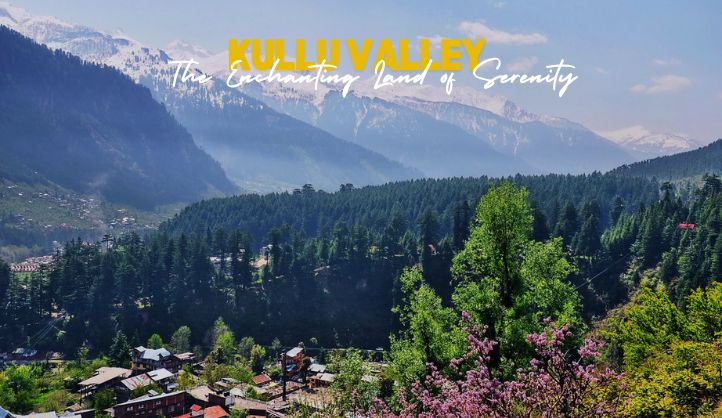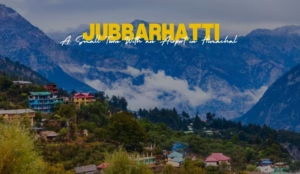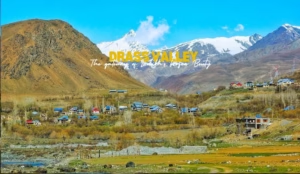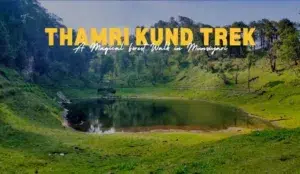Kullu Valley, in the majestic Himalayas of Himachal Pradesh, India, is a captivating destination that beckons travelers from across the globe. The “Valley of Gods” is a place of unparalleled natural beauty, cultural richness, and thrilling adventures. Whether you’re a nature enthusiast, a cultural explorer, or an adventure seeker, Kullu Valley offers something unique for everyone.
Geography and Location
Between the Pir Panjal and Dhauladhar ranges, Kullu Valley lies along the Beas River, stretching from Manali in the north to the foothills of the Himalayas in the south. Its lush green meadows, cascading waterfalls, apple orchards, and snow-clad peaks create a picturesque landscape that feels like a piece of paradise.
Historical and Cultural Significance
Kullu Valley holds a significant place in Indian mythology and history. It is believed to be the abode of many Hindu deities, and its temples, such as the Raghunath Temple and Bijli Mahadev Temple, attract pilgrims year-round. The valley is also famous for its Kullu Dussehra, a week-long festival celebrated with grandeur, showcasing the region’s rich culture, folk dances, and music.
Adventure Activities in Kullu Valley
Kullu Valley is a paradise for adventure enthusiasts, offering:
- Trekking: Trails like Chandrakhani Pass and Pin Parvati Pass.
- River Rafting: Thrill-filled rafting on the Beas River.
- Paragliding: Enjoy a bird’s-eye view of the valley at Solang Valley and Bijli Mahadev.
- Camping: Peaceful nights under the stars in places like Tirthan Valley.
Flora and Fauna
The valley’s diverse ecosystem includes deodar forests, alpine meadows, and a variety of wildlife like snow leopards, Himalayan black bears, and pheasants. The vibrant rhododendrons and apple orchards add to its charm.
Best Time to Visit
- Summer (March to June): Pleasant weather, perfect for sightseeing and trekking.
- Winter (November to February): Snow activities and picturesque snowy landscapes.
- Autumn (September to November): Clear skies and vibrant foliage.
How to Reach
- By Air: Bhuntar Airport is the nearest, about 10 km from Kullu.
- By Train: Joginder Nagar is the closest railway station, with further connections via road.
- By Road: Well-connected by buses and taxis from major cities like Delhi and Chandigarh.
Festivals and Celebrations
Dussehra
The Kullu Dussehra is a world-renowned celebration lasting a week. Unlike the rest of India, where effigies of Ravana are burnt, this festival celebrates the arrival of local deities in Kullu town. Deities from various villages gather in colorful processions, creating a vibrant spectacle.
Phagli
This spring festival marks the onset of the sowing season and is characterized by folk dances and rituals.
Folk Music and Dance
Traditional Nati dance and music are integral to Kullu’s festivals, reflecting the region’s rich cultural heritage.
Nearby Places to Explore Around Kullu Valley
The treasure trove of stunning destinations nearby enhances the beauty of Kullu Valley. Whether you seek serene landscapes, spiritual experiences, or adrenaline-pumping activities, the surrounding areas of Kullu Valley promise unforgettable experiences. Here are some must-visit places near Kullu:
1. Manali
A well-known hill station, Manali is a paradise for nature and adventure lovers. Surrounded by snow-capped mountains and lush greenery, it offers a mix of relaxation and thrill.
Top Attractions:
- Solang Valley: Perfect for paragliding, skiing, and zorbing.
- Rohtang Pass: A gateway to Ladakh offering stunning views of glaciers and peaks.
- Old Manali: Known for its bohemian vibe and cozy cafes.
- Hidimba Devi Temple: A unique wooden temple set amidst cedar forests.
2. Kasol
Nestled in the Parvati Valley, Kasol is known as the “Mini Israel of India” due to its popularity among Israeli tourists. It’s a hotspot for backpackers and trekkers.
Top Attractions:
- Parvati River: Ideal for riverside strolls.
- Chalal Village: Known for its serene ambiance and rustic charm.
- Tosh Village: A quaint hamlet offering panoramic views of the Himalayas.
3. Malana
Famous for its unique culture and ancient governance system, Malana is a secluded village in the Parvati Valley. It’s also renowned for producing high-quality hashish.
Top Attractions:
- Ancient temples like the Jamlu Devta Temple.
- Trekking trails are surrounded by verdant hills.
4. Naggar
A historical village known for its heritage and artistic significance, Naggar was once the capital of the Kullu kingdom.
Top Attractions:
- Naggar Castle: A blend of European and Himachali architecture.
- Roerich Art Gallery: Showcasing the works of Russian artist Nicholas Roerich.
- Tripura Sundari Temple: A wooden temple dedicated to the goddess Tripura.
5. Manikaran
Located in the Parvati Valley, Manikaran is a spiritual retreat known for its hot springs and sacred sites.
Top Attractions:
- Manikaran Sahib Gurudwara: A revered Sikh shrine.
- Hot Springs: Believed to have therapeutic properties.
- Harinder Mountain: Ideal for trekking and photography.
6. Tirthan Valley
A hidden gem, Tirthan Valley offers untouched natural beauty and tranquility. It’s the gateway to the Great Himalayan National Park.
Top Attractions:
- Tirthan River: Known for trout fishing and riverside camping.
- Serolsar Lake: A pristine lake surrounded by dense forests.
- Jalori Pass: A high-altitude pass offering breathtaking views.
7. Bhuntar
A small town and the gateway to Kullu Valley, Bhuntar houses the region’s airport and offers a quieter experience.
Top Attractions:
- Bishweshwar Temple: An ancient Shiva temple with intricate stone carvings.
- Bhuntar Market: A local hub for shopping and food.
8. Solang Valley
A hotspot for adventure activities, Solang Valley is a favorite among thrill-seekers and nature enthusiasts.
Top Attractions:
- Paragliding, skiing, and snowboarding during winter.
- Ropeway rides offer stunning aerial views.
- Trekking trails leading to nearby peaks.
9. Gulaba
A serene village en route to Rohtang Pass, Gulaba offers breathtaking views and is less crowded than Manali.
Top Attractions:
- Snow activities during winter.
- Photography amidst pristine landscapes.
10. Jibhi
A quaint hamlet in the Tirthan Valley, Jibhi is perfect for those seeking peace and solitude.
Top Attractions:
- Jibhi Waterfalls: A picturesque cascade surrounded by lush greenery.
- Chehni Kothi: A historical tower showcasing traditional Himachali architecture.
- Jalori Pass Trek: A rewarding trek for adventure lovers.
Conclusion
Kullu Valley is more than just a travel destination; it is an experience that stays etched in your memory. Its harmonious blend of natural beauty, cultural heritage, and thrilling adventures makes it a must-visit for anyone seeking solace or excitement in the lap of nature. Plan your trip to Kullu Valley and immerse yourself in the enchanting charm of this Himalayan gem.
FAQs
1. What are the famous festivals in Kullu Valley?
The Kullu Dussehra festival is the most famous, celebrated with vibrant processions, music, and dance.
2. Are there beginner-friendly treks in Kullu Valley?
Yes, treks like Chandrakhani Pass and Kheerganga are ideal for beginners.
3. What local foods should I try in Kullu Valley?
Try dishes like siddu, madra, and trout fish for an authentic Himachali experience.
4. Is Kullu Valley safe for solo travelers?
Yes, Kullu Valley is generally safe for solo travelers, with friendly locals and well-maintained trails.
5. Can I visit Kullu Valley during the monsoon?
While the valley looks lush during the monsoon, heavy rains can cause landslides, so it is advisable to check weather conditions before planning.
6. What are the best souvenirs to buy from Kullu Valley?
Kullu woolens, shawls, handicrafts, and local jams make great souvenirs.





